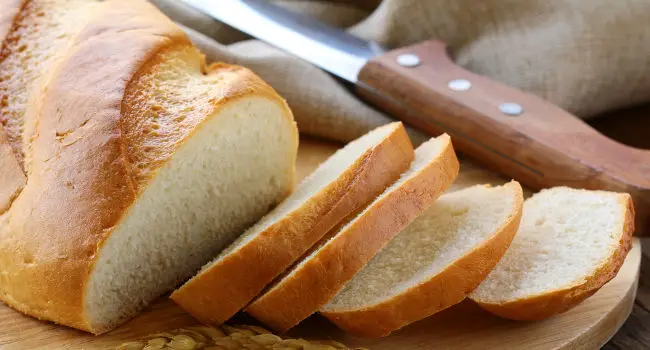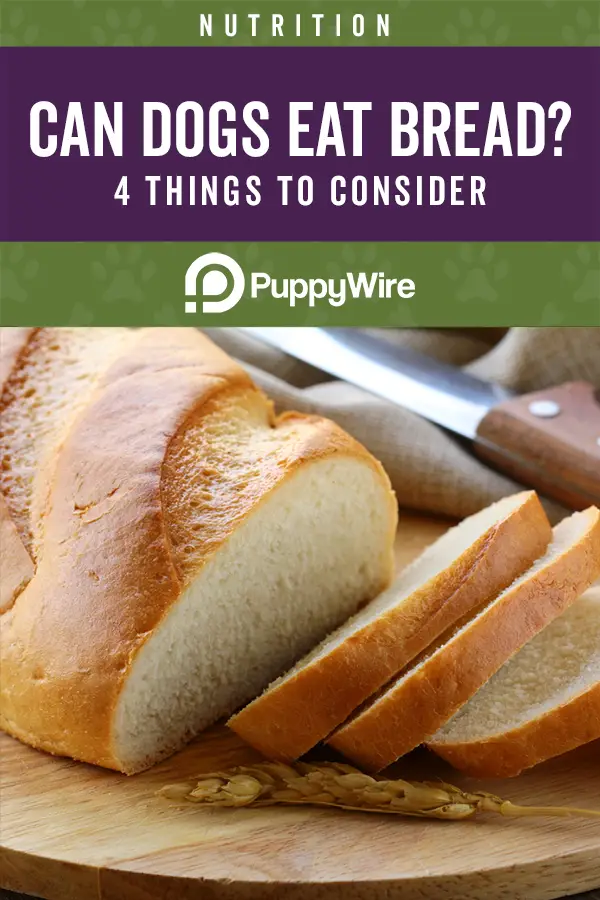Can Dogs Eat Bread? 4 Things to Consider

Can dogs eat bread? Is bread safe for dogs? You may have wondered these questions a time or two when your furry friend stared you down as you finished your meal. There is both a long and a short answer associated with these questions, and the short answer is yes.
The longer and more complex answer is still yes with a few layers and details added in. You want to know all of them before you start sharing bread with your dog because this will help you keep your dog healthy and happy throughout their lives.
Moderation is Key
The first thing that you want to understand about bread is that it is very calorie and carbohydrate dense. You’ll get roughly 70 calories per slice, and this can be way too much for your dog to handle if they routinely get large portions.
As long as you have good control over your dog’s weight, their food is balanced and nutrient-dense, and they exercise routinely, a few bites of bread here, and there isn’t going to cause a problem for them. There are very little nutrients in bread because it is widely considered to be a filler food.
Your dog doesn’t need bread in their diets to be happy and healthy, and most people feed their dog small portions of it in order to feel closer to their dog. Obviously, you’ll feed your dog less bread if they’re a smaller breed and you can get away with feeding them a little more if they’re larger.
Important Things to Consider When Giving Your Dog Bread
Before you start feeding your dog bread on a regular basis, there are several things that you want to consider. The last thing you want to do is feed your dog something and feel guilty because it didn’t agree with them. These considerations include:
- Sugar Content – Not all bread is the same, and you want to avoid bread with a high sugar content. A single slice can have up to three grams of sugar.
- Nuts and Raisin – Allowing your dog to eat nuts or raisins can lead to severe health problems because they can be toxic. It’s better to avoid them altogether than guess because the exact amount your dog has to eat to trigger this toxicity isn’t known.
- Avoid Crusts – Bread crusts have almost nothing in the way of nutrients. This is why you want to skip the crusts and feed your dog the inner portion of the bread instead.
- Allergies – Your dog can have an upset stomach if they’re allergic to gluten, grains, or wheat. Make sure that you monitor your dog after you feed them bread to look for signs of allergies.
Types of Bread to Avoid
There are dozens of different types of bread currently available. However, there are a few types that you want to avoid feeding to your dog if at all possible. They include:
- Banana Bread with Chocolate Chips – While plain banana bread may be fine for your dog, you want to avoid feeding them banana bread with chocolate chips. Chocolate can be dangerous for dogs depending on the quantity.
- Onion and Garlic Bread – Feeding your dog too much onions or garlic can lead to health problems. These two ingredients can cause red blood cell damage if your dog eats enough of them.
- Raisin Bread – As we mentioned earlier, raisins are not good for your dog. They’re not able to handle or digest it well, and it can lead to toxicity.
It’s also important that you avoid feeding your dog raw bread dough that is yeast based because this can cause them to bloat. Also, the yeast in the dough can actually ferment in your dog’s stomach and cause a toxic environment that can be fatal.
Consequences of Feeding Your Dog too Much Bread
Along with the items we listed above, there are a few other consequences that come with routinely feeding your dog bread. They include:
Alcohol Poisoning
Did you know that as yeast ferments it can release alcohol? If the yeast starts to ferments in your dog’s digestive tract, it can actually lead to alcohol poisoning if there is enough bread present.
You can start to notice common symptoms of alcohol poisoning including respiratory distress, drooling, staggering, and attempting to vomit in as little as 30 minutes or up to three hours after your dog eats raw yeast-based bread dough. This can be fatal if you don’t get veterinary attention immediately.
Bloat
Should your dog get into a bowl of raw bread dough, eating it can cause a deadly medical condition called bloat. Your dog’s stomach starts to fill with gas, and they’re not able to get rid of it.
Eventually, this bloating can cause the stomach or intestines to rupture, respiratory distress, and it can cut off circulation to your dog’s heart. Surgery is the only fix for this condition.
Weight Gain
Your dog can start to gain weight if they eat a lot of bread and they’re not active enough to burn the additional calories off. While this could be a good thing for underweight dogs, it can be a problem for dogs who are already overweight.
If you routinely feed your dog plain white bread and you notice that they look a little chunky, you might want to consider cutting back on the amount or cutting it out of their diets completely. Again, it’s always a good idea to talk to your veterinarian and get their opinion on it.
Reasons to Feed Your Dog Bread
As we talked about earlier, moderation is critical when it comes to feeding something to your dog that has so few nutrients and so many calories. But, there are reasons why you’d want to feed bread to your dog as well as how to do it safely.
Gain Weight
If your dog is underweight, your veterinarian may recommend adding small amounts of bread into their calorie-rich diet to help them put on weight. This shouldn’t be more than 5-percent of their daily diets though because there is very little nutritional value in bread except for filler and calories.
Medications
Yes, you can buy dog treats called pill pockets that are specially designed to sneak your furry friend their medications. However, a small piece of bread with peanut butter will do the same thing if you’re out of pill pockets. Again, be sparing with the peanut butter and bread amounts you use.
Treats
Tearing off or cutting a small piece of bread and adding a tiny amount of butter or peanut butter is a great way to give your dog a treat. Just make sure there isn’t artificial sweetener like xylitol because this can cause your dog’s blood sugar levels to rise to dangerous numbers.
How to Feed Your Dog Bread Safely
You could potentially feed your dog bread every day as long as it was below 5-percent of their diet. But, would you feed your kid candy every day or give your dog normal dog treats every day?
The answer is typically no because there isn’t much nutritional value packed into bread or candy to justify it. Maybe you could give your dog a small square of bread two or three times a week to reward their good behavior or just because you felt like getting them a treat.
You do want to take your dog’s size and weight into consideration as well because you’d feed a smaller dog far less bread than you’d feed to a larger dog. Also, look for wheat bread with whole grains because this is usually healthier overall when you compare it to processed bread.
Bottom Line
Bread can be a valuable treat source for your dog as long as you feed it to them in moderation and use your common sense. Can dogs eat bread? You now know that the answer is yes with conditions. Always ask your veterinarian if you’re unsure and monitor your dog after you’ve introduced something new to their diet to keep them happy and healthy.
